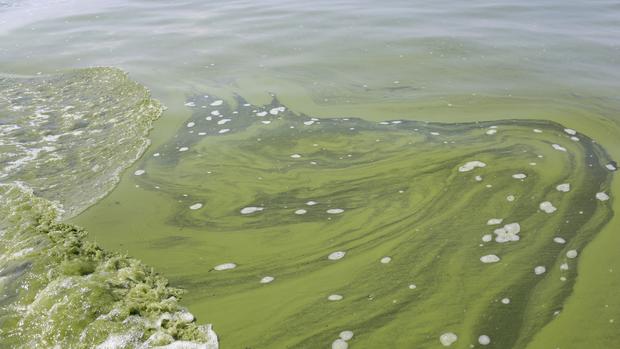"Severe" algae bloom in store for Lake Erie
Researchers are warning that Lake Erie may be in for one of the biggest algae blooms in recent years.
A new report from the National Oceanographic and Atmospheric Administration, which has begun routinely putting together bloom forecasts, found that heavy rains throughout the month of June could lead to the largest bloom of harmful algae in the Great Lake since a record-setting event in 2011 covered 2,000 square miles of water in swirling green slime.
"This forecast allows all those who need to plan to have advance warning," said Richard Stumpf, an oceanographer with NOAA's National Centers for Coastal Science.
That means cities will be prepared to start water treatment and organizations that monitor lake quality can be at the ready.
The cyanobacterial algae found in Lake Erie can decimate fish populations by consuming oxygen in the water and creating so-called dead zones. It also produces toxins that are harmful to humans, restricting access to swimming and other lake activities, and requiring drinking water to be treated and filtered.
Blooms are common in August and September -- but some blooms are worse than others. NOAA measures the severity on a 10-point scale. The bloom of 2011 -- the worst observed in the lake -- ranked a 10. Last year's bloom measured 6.5 on the index, which was high enough to contaminate the drinking water of 400,000 people in Toledo.
The estimate is that this bloom is likely to measure 8.7 in severity, and possibly as high as 9.5.
Algae requires a balance of nitrogen and phosphorus to grow. Lakes, Erie included, have plenty of the former, but don't naturally contain enough phosphorus to sustain a major bloom. However, a rainy June caused massive agricultural runoff, feeding the western part of the lake with phosphorus primarily from soil and fertilizer.
Nutrient measurements taken in the lake from March through June, referred to as the spring nutrient load, were at a record high, suggesting a big bloom to come.
Stumpf said that though the forecast is dire, conditions will vary with the winds and "much of the lake will be fine most of the time." The bloom is expected to begin this month and peak in September.
"Last summer's Toledo water crisis was a wake-up call to the serious nature of harmful algal blooms in America's waters," said Jeff Reutter, Ph.D., senior advisor to, and former director of, The Ohio State University's Sea Grant program and Stone Laboratory, in a statement. "This forecast once again focuses attention on this issue, and the urgent need to take action to address the problems caused by excessive amounts of nutrients from fertilizer, manure and sewage flowing into our lakes and streams."
